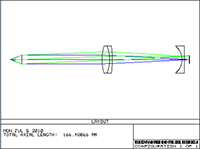Key project members: |
Optical DesignOptical design capabilities range from purely theoretical feasibility studies to design and implementation of optical systems using off-the-shelf components—and field evaluation of finished assemblies. Optical design of complex off-axis systems usually begins with a geometrical layout in 3D CAD to ensure that the physical package envelope is well defined before optical design begins. Custom ToolsetsFor a feasibility study of a deformable mirror system, I wrote custom scripts in ZEMAX (to trace the rays) and MATLAB (to format data and visualize results) and coupled them to a custom least-squares minimizer (in which I called functions from the MINPACK library in C). The software trio would find the shape of the mirror by making the optical path length constant for the entire pupil. System EvaluationFor an aerial LIDAR system, I performed a radiometric analysis of a diagnostic subsystem to predict the losses in the system and arrive at a specification for the illuminator of the subsystem. Design Synthesis and ImplementationFor a small, low-cost digital microscope, I identified a field curvature issue and suggested a simple field-flattener design from off-the-shelf components to significantly improve the performance of the system with a shortened "tube" lens. The client has placed an order for additional units. Physical OpticsI've also had experience evaluating and synthesizing design of semiconductor laser-based interferometric systems for speed measurement. Field DiagnosticsDuring preliminary field trials of a motorized zoom lens, I was able to isolate the source of the bad image as being due to a faulty element by using a "moving aperture" (hole punched on a business card). |


